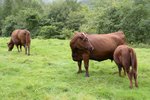
The yak is a type of bovine animal that exists in both tamed and wild varieties -- the domesticated yak (Bos grunniens) and the wild yak (Bos mutus). Although both categories are very similar physically, there are some key distinguishing factors. Both have very dark coat coloration, although wild yaks often possess light-colored chunks.
Yak Family
All yaks are part of the family Bovidae. This ungulate family is extremely extensive, and consists of a wide array of species, including sheep, goats, cows, antelopes and gazelles. The family Bovidae encompasses 137 species in total, according to Animal Diversity Web of the University of Michigan. Geographically speaking, bovids are very prevalent in Africa, although they also are common in North America, Asia and Europe. Through international introduction, some bovids also inhabit both South America and Australia.
Size Diversity in the Family Bovidae
Although many species exist under the bovid umbrella, they are in no way consistent when it comes to physical size. For instance, some buffalo and antelopes can exceed a ton in weight, while the royal antelope (Neotragus pygmaeus) often weighs just a mere 4 pounds. Many male yaks can weigh very close to 2,000 pounds. Drastic size diversity abounds within the very large family Bovidae.
Bovid Family Members Are Ruminants
One prominent factor that ties all of the members of the Bovidae family together -- including both wild and domestic yaks -- is the fact that they are all ruminants. Being a ruminant entails having a stomach that is separated into four distinct divisions -- the reticulum, the rumen, the abomasum and the omasum. Ruminant animals regorge cud that has already begun the digestion process as a means of attaining its maximum nourishment. "Cud" is a term that describes food that has already started breaking down within the animal's stomach.
Horns in Bovid Animals
Another physical trait that defines the male specimens of the family Bovidae is the presence of non-branching horns. Horns are not exclusive to the males, however, as certain varieties of female bovids also have them. Both genders of yaks possess horns, although the horns of the fairer sex are significantly smaller.
References
- The IUCN Red List of Threatened Species: Bos Mutus
- Animal Diversity Web: Bos Grunniens
- Ultimate Ungulate: Yak
- Blue Planet Biomes: Wild Yak
- American Society of Mammalogists: Bos Grunniens and Bos Mutus
- Ultimate Ungulate: Family Bovidae
- Animal Diversity Web: Bovidae
- Animal Diversity Web: Family Bovidae
- Colorado State University: Digestive Anatomy in Ruminants
Photo Credits
-
David De Lossy/Digital Vision/Getty Images




